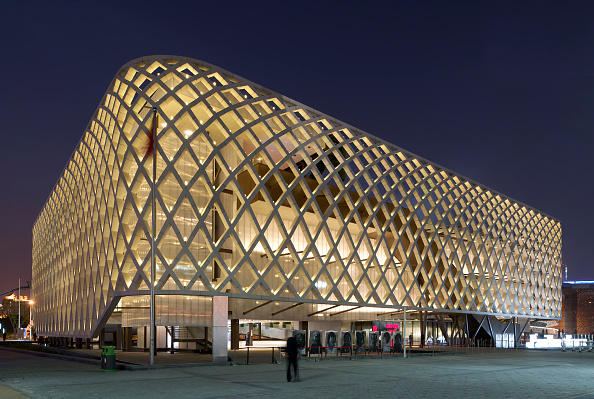It seems Rodin is having a moment. The Paris-based Musée Rodin just announced its new venue in Shanghai, China, which opens on September 25. The museum will showcase fifty sculptures by the French master, all of which were drawn from the collection in Paris. The inaugural show will unravel the connections between Rodin and Chinese culture and will include some pieces from the artist’s personal collection never before shown in public, like Ming (1368–1644) and Quing (1644–1911) dynasty porcelains, Tang dynasty terracotta figures (618 to 907 C.E.) and a statue of the deity Guanyin, a popular figure in Chinese Buddhism.
The mastermind behind Shanghai’s Centre d’Art Rodin is Chinese-French Collector Wu Jing, who created the new location in collaboration with the French museum. The project was additionally backed by the French Ministry of Culture and State Administration of Cultural Heritage of China with private funding by Jing. The opening of the museum coincides with the 60th anniversary of the diplomatic ties between France and China and furthers the “museum diplomacy strategy” that kicked off a five-year partnership that launched with the opening of the Centre Pompidou branch in Shanghai in 2019 and was renewed in 2023.

The project, which adds something new to the already vibrant Shanghai art scene, was announced during Pompidou’s Shanghai opening but is ultimately the result of eight years of conversations and planning. There wasn’t any news on the project’s status or opening date until the South China Morning Post announced it a few days ago. The Centre d’Art Rodin will be housed in the French Pavilion originally designed by architect Jacques Ferrier for the 2010 Universal Exhibition. The building previously housed the corporate art collection of Minsheng Bank, which relocated in 2010 to the Shanghai Minsheng Art Museum in the Redtown International Art Community.

This new museum supports the assertion that Shanghai is now one of China’s most dynamic art centers, but it’s worth noting that this art scene has been recently threatened. Last month, ShanghART and other galleries in the West Bund were demolished, forcing them to relocate. The demolition is part of a government development plan that will convert the West Bund into a tech and financial district after ten years as an important cultural hub for the city. ShanghART was one of the first art spaces to move into the area in 1996 and was followed by the Yuz Museum, which opened there in 2014, but the peak of the area’s success was the launch of The West Bund Art and Design Fair in 2015 that attracted the opening of other institutions such as the Long Museum, the Shanghai Center of Photography and the New Century Art Foundation.
As of today, only the Long Museum, Tank Shanghai and the Westbound Museum (now hosting the Centre Pompidou partnership) are still there. Meanwhile, the Yuz Museum is located an hour away from the center, the Shanghai Center of Photography closed permanently and the Art Tower was sold to tech giant Alibaba, which transformed it into its headquarters.
Another Rodin show in Asia draws criticism

Meanwhile, LACMA’s “True Nature: Rodin and the Age of Impressionism” is currently on at the new Renzo Piano-designed Fubon Art Museum in downtown Taipei. Commissioned by collectors Maggie Ueng and Richard Tsai’s Fubon Art Foundation in 2015 and completed this year, the facility boasts 10,000 square meters of exhibition space with an outdoor plaza for public art (as of now, a sculpture by Jaume Plensa). In a LARYY’S LIST interview, Ueng said that the foundation started as a small, personal project, but “since I have deeply benefited from arts and education, I dream of sharing it with more people to nourish the public in aesthetics and education style. When the Foundation was established in 1997, we primarily sponsored museums to help us understand more about the arts and cultural environment in Taiwan. Little by little, the Fubon Art Foundation has grown into an active art organization.”
SEE ALSO: Observer’s Guide to This Year’s Must-Visit August Art Fairs
Despite Fubon Group continuing to provide corporate sponsorship to the foundation during its own periods of financial difficulty, the Fubon Art Museum has come under fire for its hefty admission fees. Tickets for the inaugural exhibitions, including the traveling exhibition “True Nature,” go for NT $1,200 ($37)—higher even than the $30 museum entry fees in New York City and elsewhere that generated headlines last year. The Fubon Art Museum offers reduced admission for students and teachers, priced at NT $200 ($6), but most of the museums in Taipei charge the equivalent of a maximum of $10.
Ueng has responded to critics by pointing out that each exhibition costs millions of dollars to mount. The shows on view are certainly ambitious in terms of scale and production: In addition to “True Nature: Rodin and the Age of Impressionism” (through 23 September), there’s “In Touch: Collection of Fubon” (through 5 August), which features the work of six male, ethnic Chinese artists, half modern and half contemporary: Sanyu, Zao Wou-ki, Yun Gee, Paul Chiang, Su Xiaobai and Wang Huaiqing. The museum has also been criticized for not including female artists in their opening exhibitions.
Globally, museum prices are going up due to various economic pressures, and it may be that the Fubon Art Museum is just the first to break the $30 ceiling. One wonders if the Whitney, the Metropolitan Museum of Art, the Guggenheim and other major institutions will ultimately follow suit. In January, the Louvre raised its ticket price from €17 to €22 (about $18.30 to $23.70) in a 29 percent hike to cover rising energy costs and free entry for specific visitor groups including teachers, journalists and young people.

